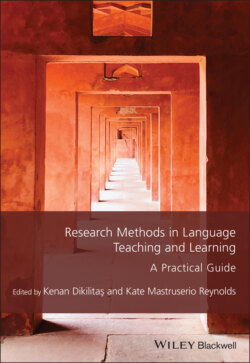Читать книгу Research Methods in Language Teaching and Learning - Группа авторов - Страница 47
Context
ОглавлениеIn Turkey, most people are monolingual in that they hear and use spoken English in formal English education, but rarely in any other settings. Kouraogo (1993) terms these contexts as “input-poor environments” since they do not offer ample input opportunities. Being exposed to limited input also delays producing output. Research studies show that EFL instruction is problematic in such contexts, because it is grammar-based (Aloreibi & Carey, 2017; Pan & Block, 2011), relies on translation and memorization (Gorsuch, 2000), and places little emphasis on teaching listening and speaking (Gürsoy et al., 2013). Although I was familiar with the context and able to anticipate possible problems, as suggested by Holliday (2007), I wanted to avoid a taken-for-granted attitude and took on “the discipline of making the familiar strange” (p. 12). This would prevent me from being biased against the problems encountered in that specific class and, hence, enable me to develop an objective researcher point of view.
Considering the lack of input and output opportunities that are available outside the classroom, it becomes critical to offer effective in-class ELT, especially the teaching of communication skills (e.g., listening, speaking, and writing) because the effectiveness of an individual’s EFL learning depends heavily on the quality of ELT provided in schools. To ensure this, research studies should be conducted to provide empirical evidence on how to design effective EFL classes and teachers must be knowledgeable about these matters. The recommendations of research studies could make it possible to combat the challenges of teaching EFL in monolingual contexts. This was my main impetus in selecting EFL speaking as the research topic of my dissertation. In doing so, I attempted to provide a model for designing an EFL speaking class that could be effective for increasing students’ engagement in their learning process.
To achieve the objectives of this research, I engaged in “thick description” (Geertz, 1973); this allowed me to select, organize, and present “interconnected data” (Holliday, 2002) that were collected using different data sources in different stages of the research. To do so, I recorded analytical memos and made notes about the context and other important issues throughout the research. These enabled me to remember the contexts and significant events that were significant to draw conclusions (Heigham & Croker, 2009). Thick description was also important for the credibility and replicability of my research. To ensure this, I reported my research context and research procedure in detail, so that the readers can understand my interpretations and construct their own interpretations (Heigham & Croker, 2009).
